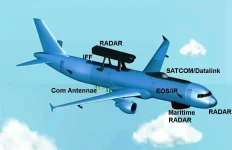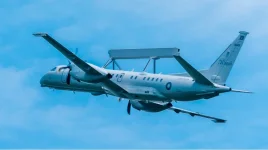- Views: 1K
- Replies: 4
The recent unveiling of a new Chinese Airborne Early Warning and Control (AEW&C) aircraft, reportedly based on the indigenous Y-20 large transport aircraft, has intensified the debate surrounding India's need to modernize its own strategic airlift and surveillance capabilities.
The development underscores China's growing military aviation prowess and highlights the strategic importance of developing indigenous solutions for critical defense platforms.
Photographs recently circulated online indicate a heavily modified Y-20, featuring a large rotodome above the fuselage, characteristic of AEW&C aircraft. This new platform, if confirmed, would represent a significant leap forward for the People's Liberation Army Air Force (PLAAF).
Currently, China's AEW&C fleet primarily consists of smaller, turboprop-based aircraft like the KJ-200 and KJ-500, along with a limited number of KJ-2000 aircraft built on the Russian-designed Il-76 airframe. A larger, jet-powered AEW&C platform based on the Y-20 would provide the PLAAF with extended range, endurance, and a more robust sensor suite, significantly enhancing its ability to monitor and control airspace.
China's successful adaptation of the Y-20, itself a domestically developed aircraft, into an AEW&C platform exemplifies a strategic focus on leveraging indigenous designs for multiple roles.
The Y-20 Xian, which entered service in 2016, offers a versatile platform with a substantial payload capacity, extended range, and modern avionics, making it suitable for a wide range of military applications. Open-source estimates suggest the Y-20 has a maximum payload capacity exceeding 66 tons, comparable to the Il-76.
This development has direct implications for India, which is currently grappling with the limitations of its aging fleet of Il-76 "Gajraj" aircraft and a limited number of American-made C-17 Globemaster III strategic airlifters.
While the 11 C-17s have proven invaluable for their high availability and operational flexibility, they are insufficient to meet India's expanding logistical and strategic requirements, especially in light of the two-front threat it faces.
The Il-76, despite its historical significance in the Indian Air Force (IAF), is becoming increasingly difficult and costly to maintain. This necessitates a strategic shift towards an indigenous replacement program that can not only address India's airlift needs but also explore the potential for platform diversification, mirroring China's approach with the Y-20.
Developing a domestically produced successor to the Il-76 would offer India several critical strategic advantages:
- Enhanced Strategic Airlift Capability: An indigenous platform would bridge the gap between the aging Il-76 and the limited number of high-demand C-17s, ensuring India possesses the necessary airlift capacity for troop movements, humanitarian assistance, and international deployments.
- Indigenous AEW&C Platform Development: A domestically produced aircraft could serve as a platform for India's own AEW&C systems. The Defence Research and Development Organisation (DRDO) has already developed the Netra AEW&C system, currently mounted on the smaller Embraer ERJ-145. A larger, jet-powered platform could offer significantly improved range, endurance, and sensor capabilities, bolstering India's air defense network.
- Cost-Effectiveness and Increased Availability: Dependence on foreign acquisitions for strategic airlifters and AEW&C systems often results in high costs, procurement delays, and potential supply chain vulnerabilities. An indigenous solution would mitigate these challenges while simultaneously stimulating the domestic aerospace industry.
- Strategic Autonomy: Developing such platforms aligns with India's "Aatmanirbhar Bharat" (Self-Reliant India) initiative, reducing dependence on foreign suppliers and allowing India to tailor solutions to its unique operational environment.
Furthermore, exploring technology transfer partnerships with established aerospace companies could help bridge capability gaps. There is also speculation that India is looking at other options such as the Embraer C-390 Millennium and Airbus A400M.
China's development of a Y-20-based AEW&C aircraft serves as a timely reminder of the critical importance of self-reliance in military aviation. For India, the development of an indigenous replacement for the Il-76 is no longer a mere option but a strategic imperative.
Such a platform would not only bolster India's logistical capabilities but also serve as a versatile, multi-role aircraft that could become the backbone of its airpower strategy for decades to come, ensuring its ability to project power and safeguard its national interests.


